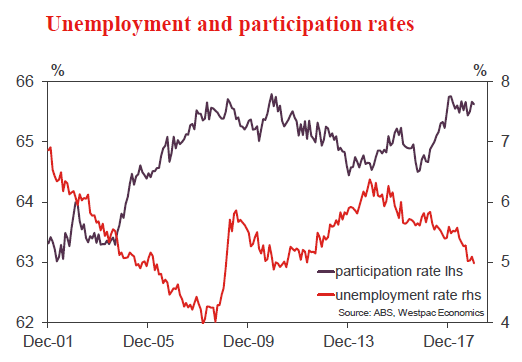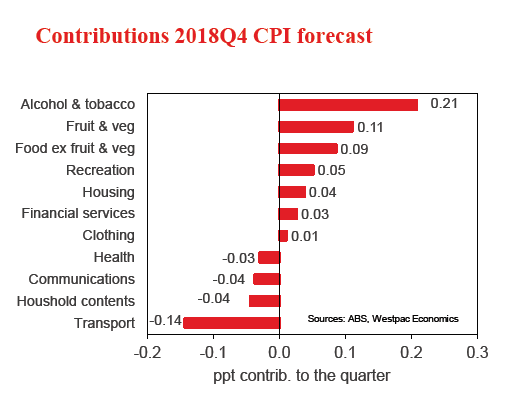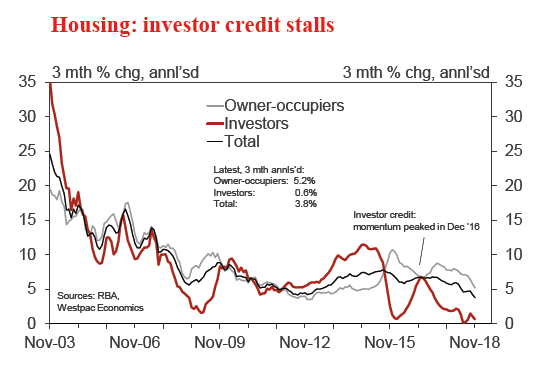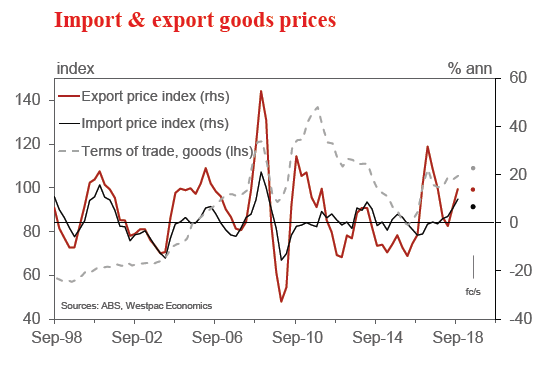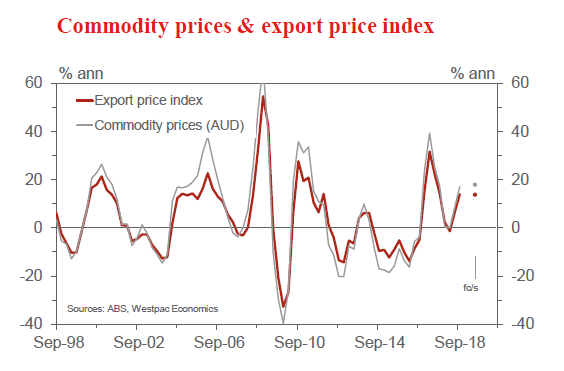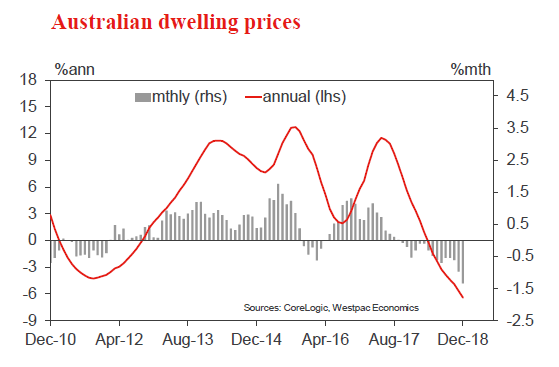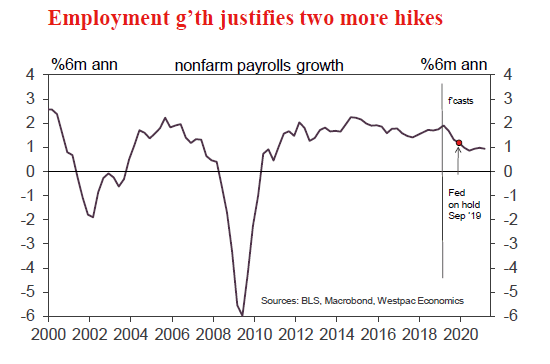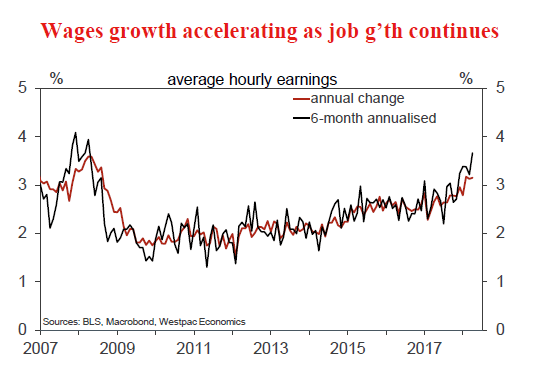Week beginning 28 January 2019
- Australia: CPI, private credit, trade prices, CoreLogic home prices, Australia Day.
- NZ: trade balance, Auckland Anniversary Day.
- China: NBS and Caixin PMI’s.
- Euro Area: CPI, GDP, unemployment, ECB President Draghi speaks.
- UK: BOE Governor Carney speaks
- US: FOMC meeting, non-farm payrolls, (GDP and PCE releases likely to be delayed due to shutdown).
- Key economic & financial forecasts.
Information contained in this report current as at 25 January 2019.
Why the RBA will keep rates on hold; next Fed hike delayed to June due to shutdown
After the usual summer recess the Reserve Bank will conduct its Board meeting on February 5, followed by a speech from Governor Lowe on February 6 and the February Statement on Monetary Policy which will print on February 8.
Of course there will be no rate change following the Board meeting but there will be considerable interest in the Governor’s Statement and the subsequent communications.
Recall that the minutes of board meetings have usually contained words along the lines of “members continued to agree that the next move in the cash rate was more likely to be an increase rather than a decrease.” Alternatively the November Statement on Monetary Policy noted “further reducing unemployment and ensuring inflation is consistent with the target. If that progress is made higher interest rates are likely to be appropriate at some point.”
But those sentiments were expressed when markets had been anticipating rate hikes. At the beginning of 2018 when Westpac was predicting the cash rate would remain on hold in both 2018 and 2019, markets had priced-in a full 25bps rate hike by end 2018. Today, markets are assessing that the next move in the cash rate will be down by 25 basis points with a probability of 60% (13bps) by year’s end.
In defence of the economists, only 11 of the 20 forecasters (Bloomberg Survey, January 12, 2018) predicted a hike or hikes in 2018 but this group did include the other three major banks, AMP, and most major investment banks.
There is no survey evidence to check how many of the “nochange nine” supported the Westpac view that rates would remain on hold through 2019 as well.
There is also, at this stage, little support from the economists for the “market view” that rates will be cut by end 2019. Since that survey in January last year Westpac has extended its “on hold view” through 2020.
The key as to whether the Reserve Bank will placate markets and adopt a pure neutral bias by eliminating the “next move up” in its commentary will hinge on how it reassesses its forecasts which will be released with the February Statement on Monetary Policy which prints on February 8.
Recall that, based on its forecasts in the November SOMP, the conclusion that the cash rate would eventually rise was reasonable.
Growth was forecast at 3.5% in 2018; 3.25% in 2019; and 3% in 2020.
Trend growth is assessed by the RBA as 2.75% (1 ppt for productivity growth and 1.75 ppt’s for labour force growth).
Three consecutive years of comfortably above trend growth could be expected to erode significant excess capacity and boost employment growth so that inflation would lift into the 2-3% target range and the unemployment rate would approach the NAIRU.
Accordingly, the Bank forecast core inflation to lift to 2.25% in 2019 and 2020 and the unemployment rate to fall to 4.75% by end 2020.
Their views on the labour market have been cautious. The unemployment rate has already reached 5% while the Wage Price Index growth rate has lifted in recent quarters to 2.3%. Scrutiny of a chart which, for the first time, was provided in the November SOMP points to a cautious forecast of WPI annual growth reaching 2 ½ per cent by end 2020.
But the September quarter GDP report has disrupted the RBA’s comfortable position. With growth only printing 0.3% in that quarter it would be necessary for Q4 to print 1.2% to achieve the November forecast of 3.5%.
The 2018 growth forecast is likely to be lowered from 3.5% to 3.0%. But what will this mean for the 2019 and 2020 growth forecasts?
We know that the Bank has assessed a minimal wealth effect on consumption and the Q3 growth report is unlikely to have changed that view. Even further negative evidence on house prices in Sydney and Melbourne is unlikely to change the qualitative assessment that the wealth effect was minimal while house prices were booming and therefore will be minimal in reverse.
Westpac differs in that regard pointing to a fall in the savings rates in NSW and Victoria over the year to September 2018 of 1.7 ppt’s. We expect some reversal of that effect in 2019 and 2020 pushing growth in consumer spending down from our previous forecast of 2.6% in each year to 2.4%.
We expect the Bank will maintain its current view that consumer spending will run at a growth rate of 3% in both 2019 and 2010. We also differ on the likely downtrend in residential construction in 2019 and to a lesser extent in 2020, “Dwelling investment has remained high and… should remain at a high level for the next year or so” (Nov SOMP).
Westpac’s growth forecasts are 2.6% in 2019 and 2.6% in 2020. Those forecasts are only slightly below trend and consistent with steady rates in 2019 and 2020.
We expect the RBA will forecast growth of 3% in 2019 and 3% in 2020. That higher growth will reflect a limited slowdown in housing construction and no meaningful wealth effect. Those growth forecasts are still above trend and likely to ensure the view that the next move in rates will be up.
If we thought the RBA was likely to lower its growth forecasts in 2019 and 2020 to 2.5% or less then we would certainly expect it to adopt an easing bias .
If a central bank expects below trend growth, particularly in the “policy” year, which in 2019 will be 2020, then we would expect an easing bias.
Other factors which may impact market thinking are the higher recent levels of BBSW and associated out of cycle hikes by some banks. The RBA will probably view those developments as likely to exacerbate housing price weakness but due to an insignificant wealth effect, will unlikely materially change their forecasts.
In regards to the US, we now expect the FOMC to remain on hold due to the Government Shutdown but continue hiking in June and September.
Readers will be aware that our forecast for FOMC policy had been three more rate hikes in March; June; and September.
Equity market volatility has undoubtedly unnerved the FOMC (S&P 500 down 20% by late December from its previous peak followed by a 12.5% rally to date). But more importantly the Government shutdown has impacted confidence and data availability. Under such a cloud of uncertainty there is little prospect for the FOMC to change rates much before mid-year.
Accordingly we do not expect the next FOMC rate hike until the June meeting this year. We do expect a follow up move in September, retaining our original timetable for the federal funds rate to peak in September 2019.
We maintain our core view that the US economy remains strong largely through a robust consumer, boosted by rising wages and strong jobs growth. We do not expect to see a marked slowdown in jobs growth and consumer spending until the September quarter.
As with our views for Australia, we are out of step with current market pricing which largely expects US rates to now be on hold.
The week that was
This week, the heat remained in Australia’s labour market, but dissipated further in China’s economy. For Brexit and the US shutdown, a resolution remains out of reach.
Starting with Australia’s labour market, employment growth again came in above expectations in December, with almost 22k new positions created in the month. At 2.2%yr, annual growth has cooled markedly over 2018 (from a peak of 3.6%yr at January); however, it remains well in excess of population growth, keeping pressure on the unemployment rate, currently 5.0%. Victoria remains the strongest of the states, their unemployment rate having fallen 1.1ppts in 2018 to 4.4% to be on par with NSW. The other states have rates nearer 6%. Looking ahead, we expect a moderation in job gains on the back of softer household demand and uncertainty around the Federal Election. That shift is likely to see the unemployment rate drift up to 5.3% around mid-2019.
Before moving on to the northern hemisphere, it is worth noting that New Zealand reported Q4 inflation this week. The result highlighted an interesting tension for the RBNZ, with tradable goods prices taking the heat out of headline inflation in the quarter (0.1% in the quarter, as tradeable prices fell 0.4%) while annual inflation remained just below the RBNZ’s 2.0%yr target band mid-point at 1.9%yr – supported by the underlying trend in non-tradeable (domestic) inflation. Our New Zealand team expects that the underlying inflation pulse will gradually strengthen hence. It will be some time before the RBNZ have to consider reacting.
Next Wednesday sees the release of Australia’s Q4 CPI. Our preview emphasises that another soft outcome is expected: a 0.3% quarterly gain for both headline and core inflation, for an annual pace near 1.5%yr. As in New Zealand, external price pressures are weak in Australia (1.1%yr); however, here domestic pressures are more subdued (1.8%yr), thanks in no small part to weak housing inflation.
Turning to China, the headlines surrounding Q4 GDP marked the update as unquestionably weak and cause for concern. Given annual growth came in at its weakest pace since the GFC (6.4%yr), pessimism is understandable, but not well founded.
First and foremost, this outcome comes after a very deliberate and purposeful policy shift by the central government to improve the quality of growth and guarantee long-term financial stability. This is the primary factor behind the softer growth of 2018, not trade tensions. More sustainable, higher productivity growth is most certainly in China’s long-term interest. Second, with the economy now more focused on quality, Chinese authorities are beginning to become more pro-active on growth, particularly investment in infrastructure. There is therefore a strong likelihood of the 6.0% annualised growth of Q4 being a near-term floor for GDP.
This does not mean that growth in China will take off however. The focus on quality will remain in place and, as per the most recent credit data and policy actions, support for growth from credit provision will only build slowly. Essential to China’s longterm prosperity is that new loans made to firms and households are based on strong standards, and further that markets and household wealth are stewarded well.
Finally to the North Atlantic, headlines regarding Brexit and the US shutdown continue to pile up, but progress towards a resolution is non-existent. Indeed, if anything, it seems the political malaise surrounding both issues is getting worse. It is little wonder then that such concern was shown by the world’s political and business leaders towards the outlook at the Davos World Economic Forum, ahead of which the IMF cut its global growth forecasts.
The one policy event of note this week was the ECB’s January meeting. Having balanced belief in the real economy and concern over the risks in recent engagements, in this instance the focus shifted more towards the risks which “have moved to the downside”. No change in forward guidance on rates has been seen yet, but is likely in March – if current trends and/or uncertainties persist – with rate hikes (the deposit rate) likely off the agenda until the December meeting – at least.
Looking ahead, next week should bring some positive headlines on trade, with high-level US/China trade talks due in Washington. The FOMC’s January meeting will also be a focus. On the other political matters however, low expectations are probably best.
Chart of the week: Australia employment
Employment ended 2018 with a sound run. In the year to December total employment grew 268.6k, or 2.2% While it is true that the momentum in the Australian labour market eased through 2018 – annual growth peaked at 3.6%yr in January – it can still be described as sound.
Given the December gain in employment it is not surprising that the unemployment rate eased back 0.1ppt to 5.0% (market median was for 5.1%). This fall was helped by a 0.1ppt moderation in the participation rate to 65.6% which limited the rise in the labour force to just 7.5k.
For 2019 we are looking for a pause in the pace in employment growth due to the economic uncertainties surrounding the Federal Election at the same time as we expect to see a moderation in momentum in NSW and Victoria on the back of a moderation in housing activity. We are expecting this to slow employment growth to below the pace of growth in the labour force lifting the unemployment rate to 5.3% around mid-2019.
New Zealand: week ahead & data wrap
Middle ground
Inflation in New Zealand is now settling into the middle of the Reserve Bank’s target range, after years of underperforming. We’re forecasting a lift in domestically-generated inflation over the next few years, but it will be a gradual process and there are some potential stumbling blocks along the way.
The Consumer Price Index for the December quarter was up by 1.9% on a year earlier, putting it close to the midpoint of the Reserve Bank’s 1-3% target range. The various ‘core’ inflation measures also sat around 2% or a little below, indicating that this was a broad-based result with no obvious distortions from temporary factors.
The December quarter itself saw a 0.1% increase, slightly below the RBNZ’s forecast of a 0.2% rise. However, that hides some important detail. At the time the RBNZ was preparing the forecasts for its November Monetary Policy Statement, fuel prices had rocketed up to new record highs on the back of rising world oil prices, a lower exchange rate, and an increase in the fuel excise duty. But fuel prices then fell surprisingly sharply into the yearend, taking some of the heat out of the overall inflation rate. This will also act to dampen inflation in the early part of 2019, but it’s a temporary influence that the RBNZ can look through.
In contrast, prices for non-tradable goods and services were up 2.7% on a year ago, the fastest increase since June 2014, compared to the RBNZ’s forecast of a slowdown to 2.4%. That difference is important because non-tradables inflation tends to be more persistent over time, and because it’s considered to be more of a product of monetary policy settings.
For much of this decade, inflation has been at the low end or even below the RBNZ’s 1-3% target range. That era of uncomfortably low inflation now seems to have passed; the next question is whether inflation could test the upper end of the target range, given that monetary policy remains very stimulatory. We’re expecting a gradual pick-up in inflation pressures over the next few years, but there are a few hurdles that need to be crossed yet.
Firstly, a pickup in inflation will depend on continued solid growth in demand. We expect GDP to grow by around 3% over this year, with support from increased government spending, export earnings, and construction. Recent data, both here and overseas, has been on the softer side of expectations, so we’ll be watching the numbers closely to get a clearer picture of the economy’s momentum.
Tradables prices have been a persistent drag on overall inflation in past years, notwithstanding the recent bounce in world oil prices. More recently there have been signs of a mild pick-up (or a slower rate of decline) in tradables inflation, reflecting the lower New Zealand dollar over the last year. We’re expecting a further fall in the exchange rate this year, which would flow through into prices for imported goods. But this doesn’t have a sustained impact on the rate of inflation.
To get a sustained rise, it needs to come from domestic sources, most importantly a pickup in wage growth. There’s a lot of evidence that the labour market is becoming tighter. The unemployment rate is at its lowest in a decade, and increasingly employers are having difficulty in finding workers.
To date, we haven’t seen that translate into faster wage growth, outside of government-mandated increases such as fair pay settlements and minimum wage hikes. It may be that the labour market has only recently moved into territory that could be considered ‘tight’ by historic standards, and that wage growth tends to have a lagging relationship with the economic cycle. Moreover, wage growth – as measured by the Labour Cost Index, which adjusts for changes in job composition and productivity gains – tends to evolve quite slowly. It could be some time before a pickup in the pace of wage growth becomes apparent in the data. Nevertheless, we think the right conditions are in place for a pickup over the next few years.
One final challenge to our view is that some of the most important components of non-tradables inflation may have already peaked. Prices for new home builds, which make up over 5% of the CPI, have slowed in the last year or so, in line with the slowdown in growth in house sales prices. With a range of Government policies aimed at dampening speculative demand in the housing market, we expect prices for both existing and new homes to remain under pressure over the next few years.
The outlook for rents, which make up almost 10% of the CPI, is less clear. There has been very little variation in rental growth at the national level in recent years. But the regional split is more telling: rental growth is actually slowing in Auckland, even as it picks up in other parts of the country.
The bottom line is that any pickup in home-grown inflation is likely to be a slow one, and it will be some time before the RBNZ needs to act to contain it. We’re expecting the Official Cash Rate to remain at its current very low level through to the end of next year, with rate hikes progressing at a very gradual pace from then on.
On a different note, this week we saw the first release of the net migration figures based on a new methodology, which uses actual outcomes 16 months after someone has entered or left the country, rather than their stated intentions on departure cards. This produces a somewhat different picture of migration over history – net inflows peaked slightly earlier, and at a lower level, than under the previous method. However, it remains the case that net migration is in decline, which is a key reason why we expect the economy’s potential growth to take a step down over the next few years.
Data Previews
Aus Q4 Consumer Price Index
- Jan 30 Last: 0.4%, WBC f/c: 0.3%
- Mkt f/c: 0.4%, Range: 0.3% to 0.6%
The September Quarter CPI printed 0.4%qtr,/1.9%yr compared to the market expectations for 0.5%qtr. The average of the core measures rose 0.3%qtr while the annual pace printed 1.7%yr, a further deceleration from 1.8%yr in Q2 2018 and 2.0% in Q1. There were isolated inflationary pressures in petrol and tobacco as well as embryonic indicators of an easing in the retail disinflationary pulse but the moderation in housing was significant.
Westpac’s forecasting 0.3%qtr for the December quarter will see the annual pace ease to 1.5%yr from 1.9%yr. Falling auto fuel, moderating housing costs & a lack of pass-through from a weaker AUD are more than offsetting a strong rise in tobacco prices. It is worth remembering that market forecasters have now overestimated the quarterly rise in the CPI for every quarter in the last two years.
Aus Dec private credit
- Jan 31, Last: 0.3%, WBC f/c: 0.3%
- Mkt f/c: 0.3%, Range: 0.3% to 0.5%
Private sector credit growth is relatively modest at 4.4% for the year, moderating progressively over the past three years as housing cools – slowing from 6.6% in 2015 to 5.6% in 2016 and 4.8% in 2017.
The November outcome was a soft one, up only 0.3%, including a +0.3% for housing and a -0.3% for personal.
Housing credit, at this late stage of the cycle, is slowing as tighter lending conditions and weaker demand see new lending decline, particularly for investors. In November housing credit grew by 0.3%, 4.9%yr (including investors, at flat mth, 1.1%yr).
Business credit, 4.4% above the level of a year ago (including a 3.0% jump over the past five months), is volatile around a modest uptrend as businesses increase investment in the real economy.
Aus Q4 import price index
- Jan 31, Last: 1.9%, WBC f/c: -0.5%
- Mkt f/c: 0.3%, Range: -1.4% to 3.5%
Prices for imported goods increased by 1.9% in the September quarter to be almost 10% above a year earlier. The lift in prices is centred on a jump in global energy prices and the impact of a lower Australian dollar.
For the December quarter, import prices are expected to ease a little, down a forecast 0.5%.
Key to the expected fall for Q4, oil prices – which corrected lower after a strong run.
Outside of fuels, there was upward pressure on the cost of imports. Notably, the Aussie took another step lower, down 0.8% on a TWI basis and falling almost 2% against the USD.
Aus Q4 export price index
- Jan 31, Last: 3.7%, WBC f/c: 2.7%
- Mkt f/c: 2.7%, Range: 1.5% to 3.5%
Export prices increased in 2018 on higher commodity prices (across iron ore, coal and oil/LNG) and a weaker Australian dollar.
For Q3, the export price index printed at 3.7%qtr, 14.0%yr.
In Q4, export prices were up again (on higher commodity prices and a lower dollar) – we expect a rise of around 2.7%, which would hold annual growth close to 14%.
The terms of trade for goods, on these estimates, increased by around 3% in the December quarter, capping off a positive year for Australian national income growth.
As to prices for services, an update will be available with the release of the Balance of Payments on March 5.
Aus Jan CoreLogic home value index
- Feb 1, Last: –1.3%, WBC f/c: –1.0%
The Australian housing market’s very weak finish to 2018 looks to have carried into early 2019. The CoreLogic home value index fell 1.3% in the December month, marking the biggest monthly fall in the correction to date, albeit likely accentuated by seasonal weakness heading into year end.
Both cyclical and seasonal weakness carried into January although extremely low levels of activity during the summer holiday period mean all housing related data should be treated with caution. The daily index points to a 1% decline for the month taking the cumulative decline since the late 2017 peak to –7.7% nationally.
US Jan FOMC meeting
- Jan 30, last 2.375%, WBC 2.375%
The first meeting for the FOMC for 2019 will be a focus for markets, particularly Chair Powell’s press conference – now scheduled for every meeting.
Since December’s meeting, the market’s awareness of global and financial risks has clearly grown. And their confidence in the US real economy diminishes every day that the Federal Government keeps its doors shut.
FOMC officials have focused on global risks to date. While these factors will remain front of mind, a more in-depth discussion of the shutdown’s impact is anticipated.
With many partial data prints unavailable, a March hike is clearly off the agenda. The market will therefore focus on what will and won’t see the FOMC act from June on.
US Jan employment report
- Feb 1, nonfarm payrolls, last 312k, WBC 150k
- Feb 1, unemployment rate, last 3.9%, WBC 3.9%
The very, very strong 312k nonfarm payrolls print of Dec (with an additional 58k in back revisions to the prior two months) was largely ignored by financial markets. This occurred because, around the same time, the ISM’s disappointed and, more importantly, Fed Chair Powell put forward a more cautious view of the outlook.
There is no reason to disregard the strength of this data print. Though being 100k over the month average of 2018, there is however reason to expect some payback in Jan. We consequently look for a 150k gain in the month.
There has been considerable uncertainty over the impact of the shutdown on these numbers. It won’t affect the payrolls count, but it is likely to add to unemployment owing to temporary layoffs.




